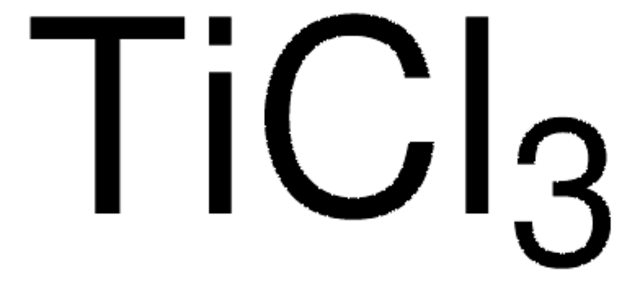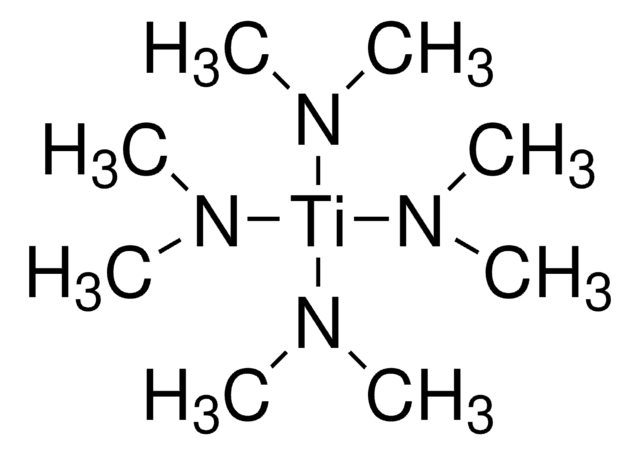697079
Titanium tetrachloride
packaged for use in deposition systems
Sinonimo/i:
Titanium(IV) chloride, TTC, Titanium tetrachloride
About This Item
Prodotti consigliati
Tensione di vapore
50 mmHg ( 55 °C)
9.6 mmHg ( 20 °C)
Livello qualitativo
Saggio
≥99.995% (trace metals analysis)
Forma fisica
liquid
Impiego in reazioni chimiche
core: titanium
reagent type: catalyst
P. eboll.
135-136 °C (lit.)
Punto di fusione
−25 °C (lit.)
Densità
1.73 g/mL at 20 °C (lit.)
Stringa SMILE
Cl[Ti](Cl)(Cl)Cl
InChI
1S/4ClH.Ti/h4*1H;/q;;;;+4/p-4
XJDNKRIXUMDJCW-UHFFFAOYSA-J
Cerchi prodotti simili? Visita Guida al confronto tra prodotti
Descrizione generale
Applicazioni
- γ,δ-unsaturated alcohols from allylsilanes and carbonyl compounds,
- N-Phosphinoylimines and N-sulphonylimines from aromatic aldehydes,
- Homoallyl ethers from allylsilanes and acetals.6
Avvertenze
Danger
Indicazioni di pericolo
Classi di pericolo
Acute Tox. 1 Inhalation - Eye Dam. 1 - Skin Corr. 1B - STOT SE 3
Organi bersaglio
Respiratory system
Rischi supp
Codice della classe di stoccaggio
6.1A - Combustible acute toxic Cat. 1 and 2 / very toxic hazardous materials
Classe di pericolosità dell'acqua (WGK)
WGK 1
Punto d’infiammabilità (°F)
Not applicable
Punto d’infiammabilità (°C)
Not applicable
Dispositivi di protezione individuale
Faceshields, Gloves, Goggles, type ABEK (EN14387) respirator filter
Certificati d'analisi (COA)
Cerca il Certificati d'analisi (COA) digitando il numero di lotto/batch corrispondente. I numeri di lotto o di batch sono stampati sull'etichetta dei prodotti dopo la parola ‘Lotto’ o ‘Batch’.
Possiedi già questo prodotto?
I documenti relativi ai prodotti acquistati recentemente sono disponibili nell’Archivio dei documenti.
Articoli
igma-Aldrich.com presents an article regarding the savannah ALD system - an excellent tool for atomic layer deposition.
Since the demonstration of the first practical solar cell 60 years ago, research on novel materials, improved solar cell design and structure, and innovative manufacturing processes have all contributed to a continuous increase in the efficiency of photovoltaic (PV) devices.
Nanomaterials are considered a route to the innovations required for large-scale implementation of renewable energy technologies in society to make our life sustainable.
The properties of many devices are limited by the intrinsic properties of the materials that compose them.
Il team dei nostri ricercatori vanta grande esperienza in tutte le aree della ricerca quali Life Science, scienza dei materiali, sintesi chimica, cromatografia, discipline analitiche, ecc..
Contatta l'Assistenza Tecnica.






